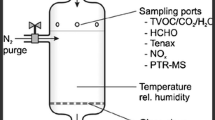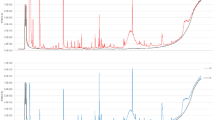Abstract
Background
Human breath contains volatile organic compounds (VOCs) that are biomarkers of breast cancer. We investigated the positive and negative predictive values (PPV and NPV) of breath VOC biomarkers as indicators of breast cancer risk.
Methods
We employed ultra-clean breath collection balloons to collect breath samples from 54 women with biopsy-proven breast cancer and 124 cancer-free controls. Breath VOCs were analyzed with gas chromatography (GC) combined with either mass spectrometry (GC MS) or surface acoustic wave detection (GC SAW). Chromatograms were randomly assigned to a training set or a validation set. Monte Carlo analysis identified significant breath VOC biomarkers of breast cancer in the training set, and these biomarkers were incorporated into a multivariate algorithm to predict disease in the validation set. In the unsplit dataset, the predictive algorithms generated discriminant function (DF) values that varied with sensitivity, specificity, PPV and NPV.
Results
Using GC MS, test accuracy = 90% (area under curve of receiver operating characteristic in unsplit dataset) and cross-validated accuracy = 77%. Using GC SAW, test accuracy = 86% and cross-validated accuracy = 74%. With both assays, a low DF value was associated with a low risk of breast cancer (NPV > 99.9%). A high DF value was associated with a high risk of breast cancer and PPV rising to 100%.
Conclusion
Analysis of breath VOC samples collected with ultra-clean balloons detected biomarkers that accurately predicted risk of breast cancer.




Similar content being viewed by others
References
Health, United States (2015) Centers for Disease Control and Prevention National Center for Health Statistics
Jiang Y, Miglioretti DL, Metz CE, Schmidt RA (2007) Breast cancer detection rate: designing imaging trials to demonstrate improvements. Radiology 243:360–367
White A, Miller J, Royalty J et al (2015) Clinical outcomes of mammography in the National Breast and Cervical Cancer Early Detection Program, 2009–2012. Cancer Causes Control 26:723–732
Cardoso MJ, Cardoso F (2017) Editorial: overdoing in breast cancer: the risks of over-screening, over-diagnosing and over-treating the disease. Breast 31:260
Pace LE, Keating NL (2014) A systematic assessment of benefits and risks to guide breast cancer screening decisions. JAMA 311:1327–1335
Mangler M, Freitag C, Lanowska M, Staeck O, Schneider A, Speiser D (2012) Volatile organic compounds (VOCs) in exhaled breath of patients with breast cancer in a clinical setting. Ginekol Pol 83:730–736
Patterson SG, Bayer CW, Hendry RJ et al (2011) Breath analysis by mass spectrometry: a new tool for breast cancer detection? Am Surg 77:747–751
Peng G, Hakim M, Broza YY et al (2010) Detection of lung, breast, colorectal, and prostate cancers from exhaled breath using a single array of nanosensors. Br J Cancer 103:542–551
Xu Y, Lee H, Hu Y, Huang J, Kim S, Yun M (2013) Detection and identification of breast cancer volatile organic compounds biomarkers using highly-sensitive single nanowire array on a chip. J Biomed Nanotechnol 9:1164–1172
McCulloch M, Jezierski T, Broffman M, Hubbard A, Turner K, Janecki T (2006) Diagnostic accuracy of canine scent detection in early- and late-stage lung and breast cancers. Integr Cancer Ther 5:30–39
Phillips M, Cataneo R, Ditkoff B et al (2003) Volatile markers of breast cancer in the breath. Breast J 9:184–191
Phillips M, Cataneo RN, Ditkoff BA et al (2006) Prediction of breast cancer using volatile biomarkers in the breath. Breast Cancer Res Treat 99:19–21
Phillips M, Cataneo RN, Saunders C, Hope P, Schmitt P, Wai J (2010) Volatile biomarkers in the breath of women with breast cancer. J Breath Res 4:026003
Phillips M, Beatty JD, Cataneo RN et al (2014) Rapid point-of-care breath test for biomarkers of breast cancer and abnormal mammograms. PLoS ONE 9:e90226
Phillips M, Cataneo R, Lebauer C, Mundada M, Saunders C (2016) Breath mass ion biomarkers of breast cancer. J Breath Res 11(1):016004
Jezierska-Drutel A, Rosenzweig SA, Neumann CA (2013) Role of oxidative stress and the microenvironment in breast cancer development and progression. Adv Cancer Res 119:107–125
Balliet RM, Capparelli C, Guido C et al (2011) Mitochondrial oxidative stress in cancer-associated fibroblasts drives lactate production, promoting breast cancer tumor growth: understanding the aging and cancer connection. Cell Cycle 10:4065–4073
Kneepkens CM, Ferreira C, Lepage G, Roy CC (1992) The hydrocarbon breath test in the study of lipid peroxidation: principles and practice. Clin Invest Med 15:163–186
Kneepkens CM, Lepage G, Roy CC (1994) The potential of the hydrocarbon breath test as a measure of lipid peroxidation. Free Radic Biol Med 17:127–160
Aghdassi E, Allard JP (2000) Breath alkanes as a marker of oxidative stress in different clinical conditions. Free Radic Biol Med 28:880–886
Spink DC, Katz BH, Hussain MM et al (2002) Induction of CYP1A1 and CYP1B1 in T-47D human breast cancer cells by benzo[a]pyrene is diminished by arsenite. Drug Metab Dispos 30:262–269
Brueggemeier RW, Diaz-Cruz ES (2006) Relationship between aromatase and cyclooxygenases in breast cancer: potential for new therapeutic approaches. Minerva Endocrinol 31:13–26
Phillips M (2017) Inventor USPTO Application no. 20170188887. Ultra-clean bag or balloon for collection of volatile organic compounds in breath or air, USA. https://www.google.com/patents/US20170188887
Phillips M (1997) Method for the collection and assay of volatile organic compounds in breath. Anal Biochem 247:272–278
Phillips M, Altorki N, Austin JH et al (2008) Detection of lung cancer using weighted digital analysis of breath biomarkers. Clin Chim Acta 393:76–84
Hanley JA, McNeil BJ (1982) The meaning and use of the area under a receiver operating characteristic (ROC) curve. Radiology 143:29–36
A Prospective Validation Study of a Rapid Point-of-Care Breath Test for Breast Cancer (2017) National Institutes of Health https://clinicaltrials.gov/ct2/show/NCT02888366
Li J, Peng Y, Liu Y et al (2014) Investigation of potential breath biomarkers for the early diagnosis of breast cancer using gas chromatography-mass spectrometry. Clin Chim Acta 436:59–67
Miekisch W, Herbig J, Schubert JK (2012) Data interpretation in breath biomarker research: pitfalls and directions. J Breath Res 6:036007
Silva CL, Perestrelo R, Silva P, Tomas H, Camara JS (2017) Volatile metabolomic signature of human breast cancer cell lines. Sci Rep 7:43969
Centers for Disease Control & Prevention: Cancer among women. http://www.cdc.gov/cancer/dcpc/data/women.htm
National Cancer Institute: Breast cancer. http://www.cancer.gov/cancertopics/types/breast
Acknowledgements
Michael Phillips is President and CEO of Menssana Research, Inc. Schmitt & Associates, Newark, NJ, maintained a database of chromatograms and Daniel Strano analyzed the data. We thank Jan Huston MD (deceased) for her sustained support and encouragement, and for coordinating the clinical study at Hackensack UMC Mountainside. Omar Ornelas of Grupo Mexlab performed GC SAW analysis of eight samples from Universidad de Guadalajara & Instituto Jalisciense de Cancerologia. Menssana Research Inc has no commercial, scientific, or other relationships with Ornelas or Grupo Mexlab or their affiliates.
Author information
Authors and Affiliations
Corresponding author
Rights and permissions
About this article
Cite this article
Phillips, M., Cataneo, R.N., Cruz-Ramos, J.A. et al. Prediction of breast cancer risk with volatile biomarkers in breath. Breast Cancer Res Treat 170, 343–350 (2018). https://doi.org/10.1007/s10549-018-4764-4
Received:
Accepted:
Published:
Issue Date:
DOI: https://doi.org/10.1007/s10549-018-4764-4




